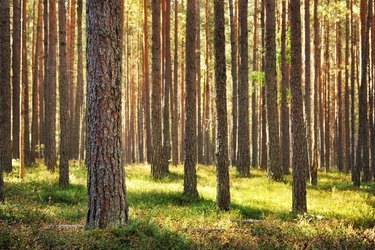
Choosing the right type of wood for your project requires a little background knowledge of the traits of different woods. Cedar and pine are two common options used for many building projects, both of which have a variety of subspecies scattered around the world. Domestically, both pine and cedar are harvested mainly in the Northwest. Builders use both varieties for trim, furniture and structural lumber. Pine and cedar are prized by woodworkers for different reasons, but the two species often overlap in how they're used.
Hard or Soft
Video of the Day
Pine and cedar are both softwoods, which means the trees are evergreens or conifers. Even though they're called softwoods, they're actually very strong. Many woodworkers and builders choose softwoods because they're easier to work with than hardwoods. The Janka scale ranks all wood for hardness, with a higher number correlating with a harder wood. The rating for white pine, one of the most common varieties, is 420. Yellow pine earns an 870, while cedar comes in at an even 900. For the sake of comparison, red oak gets a 1,290 on the Janka scale.
Video of the Day
White Pine
White pine is a versatile, all-purpose wood. It's affordable, readily available, light, easy to work with and finishes nicely. Door and window casings and trim moldings often feature white pine construction. The flexibility in the wood helps the molding and trim bend to fit walls that aren't perfectly straight.
White pine typically doesn't need to be drilled before nailing or driving screws, and it's not prone to cracking if fasteners are located more than 3/4 inch from the edges. White pine is widely used for beginner or student woodworking classes because it's affordable, easy to cut, glue and sand, and it accepts stain, clear finishes or paint equally well.
Yellow Pine
Yellow pine is much harder than white pine. It looks similar and features a straight-grain amber color. It's often used as a construction or structural building material, and yellow pine studs and beams used in framing are comparable in strength and stiffness to Douglas fir. Sometimes referred to as Southern pine, the straight-grain strength and resiliency make it suitable for exterior window and door trim, fascia and other exterior trim. Although yellow pine lacks the weather-resistant qualities of cedar, it performs well when sealed and maintained on a regular basis. Pressure-treated yellow pine is used commercially for permanent wood foundations and marine applications, such as piers and bridges.
Rough-Sawn Cedar
Cedar is dimensionally stable and resists shrinking and swelling. Cedar resists weathering, decay and insect infestation, so it's perfect for siding, fencing and exterior trim. Home builders choose cedar for areas where humidity and fluctuating temperatures are an issue. Rough-surfaced or rough-sawn cedar has a rough, fibrous appearance. The rugged beauty of rough-sawn cedar lends a rustic, lodge-like appearance to the exterior of any building when used as trim or siding. Other exterior uses include shingles, decking, fencing and outdoor fixtures, including furniture. Cedar can be left natural or stained or painted.
Aromatic and Clear Cedar
Clear cedar is rough-sawn cedar that's finished flat and clean. Reddish-brown swirls and knots make clear cedar an attractive trim material for interior decorating. Furniture makers use clear cedar for Adirondack chairs, tables and other outdoor furniture. Clear cedar sometimes appears on acoustical guitar soundboards. It has a pleasant aroma when cut.
Aromatic cedar produces the trademark scent prized by woodworkers for lining cedar chests, drawers and closets. The aromatic scent repels moths and produces that waft of clean, clear aroma every time you open the door. As a bonus, aromatic cedar holds up well in high-moisture environments such as saunas.
- The Wood Database: Aromatic Red Cedar
- Street Directory: Cedar Wood Benefits
- The Wood Database: Western Red Cedar
- Southern Pine: New Design Values
- Woodworking Tips: Pampering Pine, Part 1
- Tiny Timbers: Janka Hardness Scale
- Kitchen Cabinet Kings: What Is Softwood?
- Utah State University: Selecting Wood Furniture